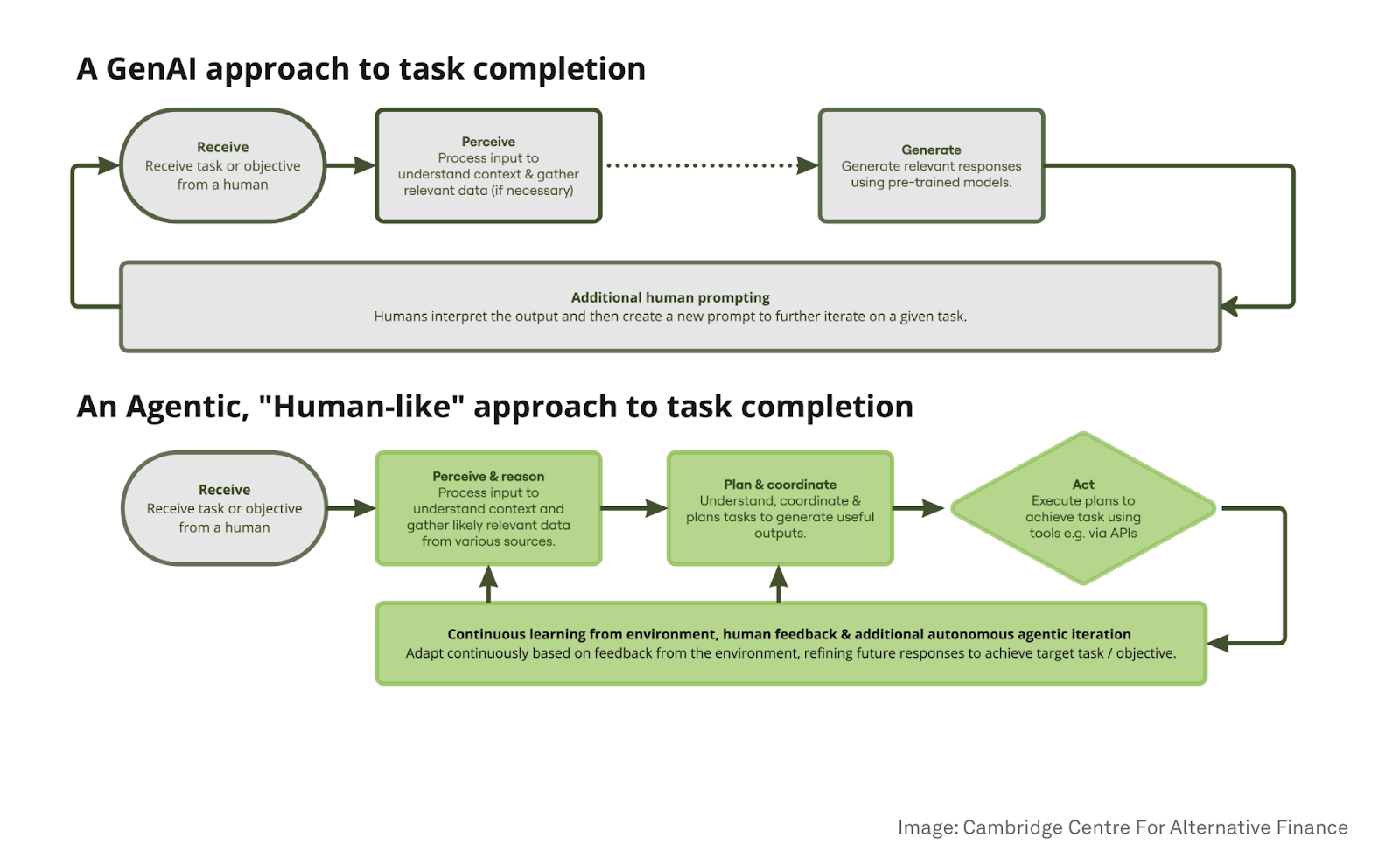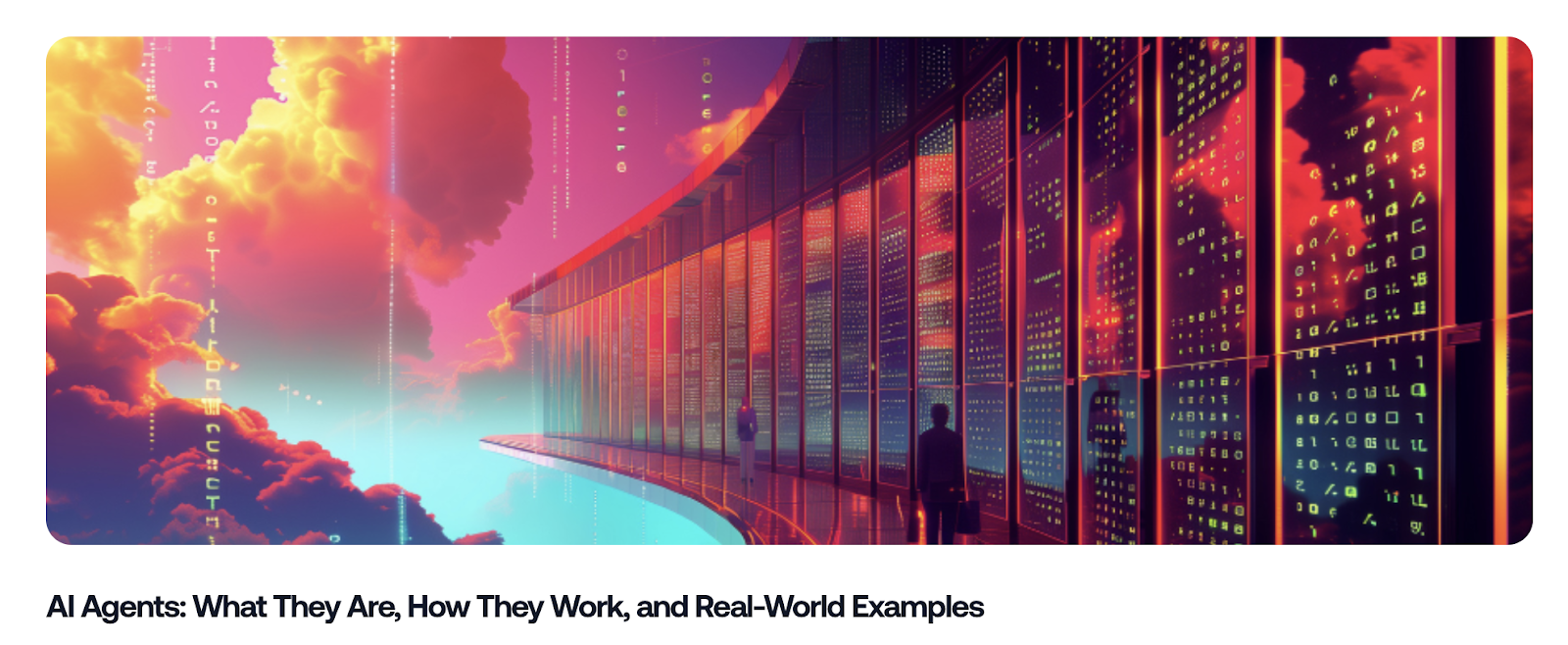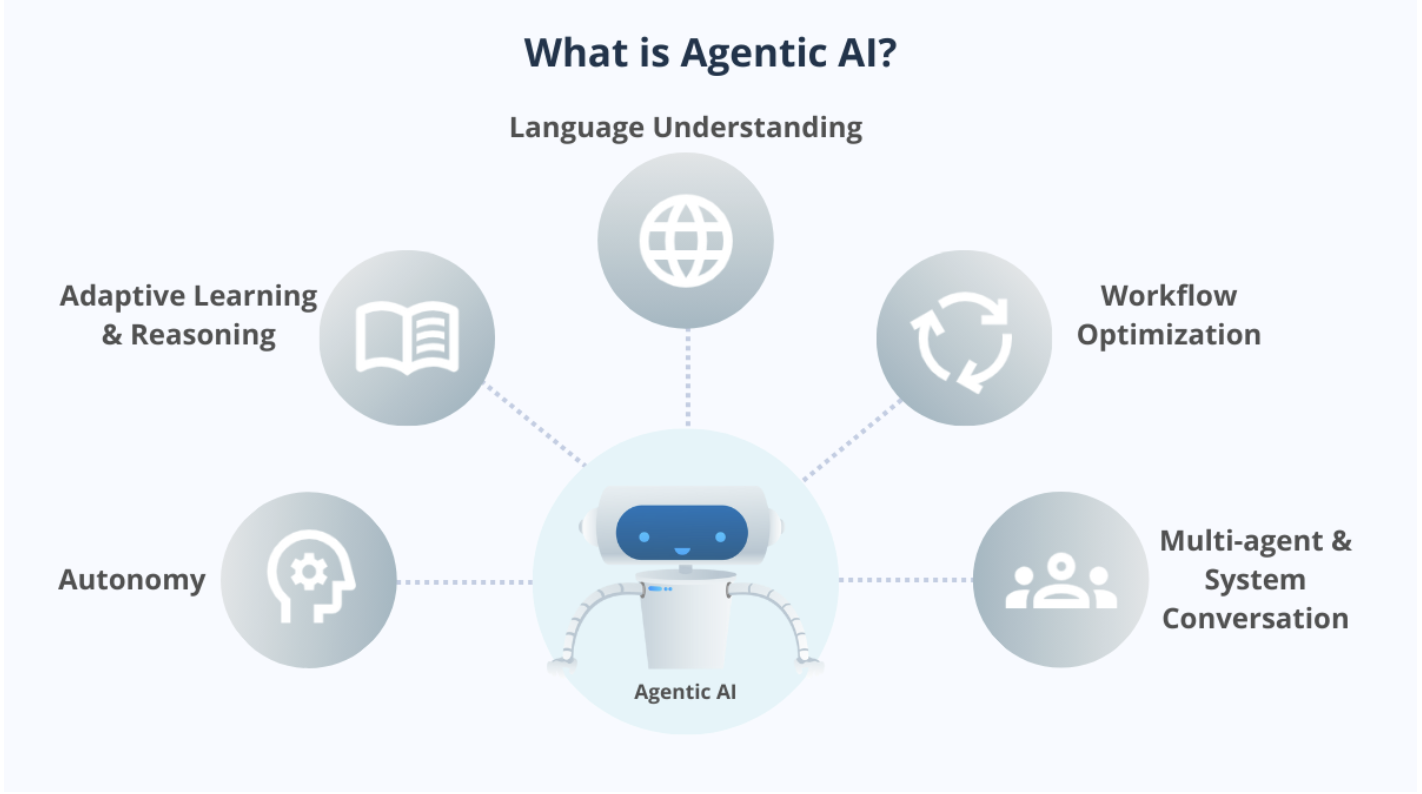We’re witnessing a fascinating shift in artificial intelligence (AI), One that moves beyond content generation toward autonomous action.
Generative AI (gen AI), powered by large language models like GPT or Claude, has shown the world what generative AI tools can do with language, image, and code. But that has now led us to ask: “Great! But what’s next?” And more importantly: “How do we turn all this AI output into a real, operational outcome?”
That’s where agentic AI comes in.
If gen AI retrieves and generates a response contextually, agentic AI takes it to the next level by getting things done. It takes information and leverages it into a process to drive an outcome. Agentic AI is capable of reasoning, decision making, taking initiative, and executing tasks across systems with minimal human input.
This distinction between agentic AI and generative AI is becoming increasingly important as enterprises adopt automation at scale.
Is Agentic AI a more autonomous form of Generative AI?
Not quite.
Generative AI is a type of artificial intelligence that creates novel content based on patterns learned from existing data. Using deep learning and large language models, it generates text, images, video, audio, and even software code with a prompt. By analysing vast amounts of information, generative AI tools produce outputs by identifying patterns within that data.
While agentic AI builds on generative models, it’s more than just a smarter chatbot or an advanced text generator.
Agentic AI operates with minimal human oversight, interpreting inputs, making choices, and executing actions independently. This agent-based approach allows AI to move beyond singular outputs and support broader business processes.
For example, AI agents can be applied to complex tasks like invoice processing, handling customer service inquiries, and making product recommendations.
Where generative AI excels at content creation, agentic AI systems are designed to act. They make decisions, take initiative, work toward goals, and interact with tools, data analysis, and humans.
Now that you know what gen AI and agentic AI are, let’s look at some key differences between them.
TL;DR: Agentic AI vs Generative AI
The differences between them are:
What’s the key difference in agentic AI vs generative AI?
Generative AI creates content based on prompts, while agentic AI systems don’t just generate, they act. Agentic AI reasons, uses tools, adapts, and executes tasks autonomously to achieve specific goals.
Unlike generative AI, which is reactive, AI agents can perceive data from multiple sources, apply decision making, act on it, and learn from the outcomes.
This four-step process (perceive, reason, act, learn) enables agentic AI to handle complex tasks that generative AI cannot address due to its reactive nature:

Goals of Agentic AI vs Generative AI
The goals of agentic AI vs generative AI differ fundamentally, reflecting their distinct functionalities and applications within artificial intelligence.
Generative AI goals
1. Enhancing content productivity
One of the main goals of generative AI is producing high volumes of content quickly. With the help of large language models, teams can move from brainstorming to drafts, edits, and publishing in record time, including content tailored to specific audiences and use cases. This helps creators, marketers, researchers, and professionals save significant time and effort.
2. Enhancing user experience
Generative AI also helps you enhance user experiences by providing tailored content and solutions. By analyzing user inputs and preferences, it can generate personalized recommendations, automate creative processes, and improve engagement across various platforms.
3. Support decision making
While gen AI isn’t primarily focused on decision-making, it can assist in this area by providing insights and generating data that inform business strategies.
For example, it can create reports or visualizations that help organizations understand trends and make informed decisions.
Agentic AI goals
1 Autonomy and decision making
Agentic AI systems are designed for autonomy. They make decisions and take actions without the need for constant human oversight. This allows organisations to run complex workflows that adapt to dynamic environments and shifting objectives.
2. Refining strategy and performance on the go
Agentic AI agents solve complex tasks by continuously learning from interactions and adapting strategies based on real-time data. Its ability to learn from interactions and experiences enables it to continuously update its knowledge, refine its strategies, and enhance its overall performance.
This capability allows it to handle dynamic environments effectively, making it suitable for applications in areas like robotics, customer service automation, and supply chain management.
3. Workflow automation
A key goal of agentic AI is optimising and automating workflows. By integrating with existing systems, AI agents can streamline business processes, manage tasks end-to-end, and improve operational efficiency. This leads to reduced manual effort, cost savings, and more scalable growth for organisations.
How Agentic AI Addresses Generative AI’s Limitations
Generative AI is powerful at producing content, but it falls short when things get more complex. It doesn’t take initiative, remember the context, or handle multi-step tasks without constant prompting.
Another limitation is data quality. Generative AI output is only as good as the training data it learned from. If that data contains biases, is incomplete, or poorly cleaned, the generated content will mirror those flaws.
At its core, gen AI is excellent at pattern matching and prediction, whether it’s the next word, pixel, or line of code, but it often lacks real comprehension. And one of the biggest frustrations for users is AI hallucinations: confidently presenting information that simply isn’t true.
These hallucinations can create serious risks in industries like healthcare or finance, where accuracy is critical. Transparency is another issue, since most large language models operate as “black boxes,” making it difficult to understand how outputs are generated. This lack of clarity can reduce trust and hinder adoption in regulated industries.
So, how does agentic AI address these limitations?
Unlike generative AI, agentic AI systems don’t just generate answers, they execute. They bring together perception, reasoning, and action in a closed feedback loop. Agentic AI can trigger tools, make autonomous decisions, and adapt based on real-time feedback.
When deploying AI in real-world operations, organisations need more than answers, they need execution. Agentic AI agents collaborate across systems, enabling multi-agent workflows that handle complex processes with minimal human oversight.
On that note, if you’d like to go deeper into how these AI agents work in practice, check out our detailed primer with real-world examples:

How Does Agentic AI Expand on Generative AI’s Capabilities?
Generative AI is a robust tool that supports a wide range of professionals, from creatives to engineers, researchers, and scientists. For instance, generative AI tools can transform text into an image, convert images into music, or summarise video content into text.
But in real-world applications, businesses need more than an AI that simply responds. They require enterprise AI systems capable of independently handling complex workflows, completing tasks end-to-end, and adapting to changing contexts. They need AI that can proactively predict, strategise, and act autonomously to achieve business goals.
This is exactly where agentic AI comes in.
It significantly expands the capabilities of generative AI by introducing autonomy, advanced problem-solving abilities, and workflow automation.
Its ability to learn and adapt in real time makes agentic AI highly effective in dynamic environments, helping organisations innovate and improve operational efficiency.
Let’s look at their features in detail.
Gen AI features
Content creation
Generative AI excels at producing new and original content, including text, images, audio, and video. It can generate coherent and contextually relevant outputs based on user prompts, mimicking human creativity.
Training data
This type of AI relies on large datasets to learn patterns and structures. It uses advanced algorithms, such as generative adversarial networks (GANs), to create outputs that reflect the features of the training data.
Human-like interaction
Generative AI uses natural language processing to produce human-like text and responses. This makes it valuable for applications like chatbots and virtual assistants, where user experience and conversational engagement are key.
Adaptability
Generative AI can adapt its outputs based on the context and nuances of the input it receives. This flexibility allows it to generate tailored content that meets specific user needs or preferences
Agentic AI features
The key features of Agentic AI are:
Autonomy and decision making
Agentic AI systems operate with autonomy, driven by objectives. They can determine and execute actions needed to achieve goals without ongoing human intervention.
Problem solving
Agentic AI solves problems through a four-stage process: perception, reasoning, action, and learning. AI agents collect and process data, apply reasoning via large language models, and collaborate with external tools. They then refine strategies continuously based on feedback, improving outcomes over time.
Learning
With advanced natural language processing, agentic AI understands human language at a deep semantic level, enabling richer, more meaningful interactions.
Workflow optimization
It combines language understanding with reasoning and decision-making to optimize business processes, enhance resource allocation, and identify automation opportunities.
Multi-agent systems
Agentic AI enables collaboration across multiple AI agents and tools, creating multi-agent systems capable of managing intricate workflows. It can connect with different systems and tools to execute various tasks.
For instance, in research, it can collect data, analyze findings, and create reports, while coordinating with other AI agents to enhance efficiency. This interconnectedness allows AI systems to collaborate and achieve shared objectives.

While Generative AI excels in content creation, agentic AI's capabilities extend to various domains, including cybersecurity, healthcare, and complex data analysis.
For example, it can autonomously detect and respond to security threats or manage patient interactions in healthcare settings, showcasing its versatility beyond mere content generation.
Agentic AI vs Generative AI: Use Cases
When comparing agentic AI vs generative AI, both bring diverse use cases where their applications add significant value. Let’s look at some practical examples.
Generative AI use cases
1. Content creation
Generative AI excels in producing creative content such as marketing materials, social media posts, and even video scripts. It can generate high-quality visuals and text from user prompts, reducing the time and resources required for content production. Beyond text and visuals, generative AI tools are being used to design prototypes, create training datasets for machine learning, and even assist in drug discovery. Its ability to generate synthetic data accelerates research while cutting costs, helping teams test and validate models more efficiently.
2. Customer interaction
In customer service, generative AI power chatbots that provide instant, context-aware responses to customer inquiries. This improves the overall user experience and reduces workload for human agents.
3. Software development
Generative AI assists developers by producing code snippets from natural language descriptions, helping accelerate software development and increase productivity.
4. Marketing
In marketing, gen AI can create personalized email campaigns and promotional content tailored to specific customer segments, improving engagement and boosting conversion rates.
5. Research and development
Generative AI supports R&D by generating hypotheses, analyzing data trends, and creating synthetic data for testing new products or services. This accelerates innovation cycles and reduces costs.
Agentic AI use cases
1. Cybersecurity
Agentic AI systems enhance cybersecurity by autonomously monitoring for vulnerabilities and responding to threats in real time, outperforming traditional detection and prevention tools.
2 Portfolio management
In finance, agentic AI manages investment portfolios by analyzing market data, making buy/sell decisions, and adjusting strategies based on market conditions, thus automating complex financial processes.
3 Healthcare
In healthcare, agentic AI can monitor patients, manage appointments, and assist in diagnostics by analyzing patient data to suggest treatment options. Hence, improving patient care and operational efficiency.
4 Customer experience
Agentic AI, through its agents, can autonomously handle complex customer inquiries. It can learn from interactions to provide personalized solutions. For instance, it can analyze live shipping data, determine the cause of delays, and offer resolutions like expedited orders or refunds without human intervention.
5. Supply Chain Management
Agentic AI optimizes supply chains by predicting risks, managing inventory, and dynamically adjusting logistics based on real-time data, which helps in maintaining resilience against disruptions. For example, an agentic AI system can reroute shipments instantly during weather events or automatically rebalance stock levels across multiple warehouses. This responsiveness reduces delays, improves customer satisfaction, and lowers overhead costs compared to manual intervention.
6. Loan Processing
AI agents expedite loan approvals by automatically reviewing applications, verifying applicant details, and requesting missing documents.
AI agents can automatically review loan applications, verify information, check creditworthiness, and approve them if they meet the criteria, speeding up the process and improving customer satisfaction.
7. Virtual R&D Assistants
AI-powered virtual R&D assistants greatly reduce the time researchers spend finding relevant papers, patents, and technical documents from large databases, speeding up innovation. These agents can assess findings, identify gaps, and even propose new ideas based on data patterns.
Some advanced systems can simulate research or product testing, allowing teams to analyze results before real-world trials. This reduces the cost and effort of R&D, improves decision-making, and accelerates discovery.
It’s a wrap
So let's pull this together.
When it comes to agentic AI vs generative AI, the distinction is clear: generative AI is great for creating content, while agentic AI takes things further. With autonomous AI agents capable of decision making and workflow automation, businesses can move from simple outputs to real, actionable outcomes.
These AI agents can plan, adapt, and execute complex workflows, turning intelligence into measurable business results. While generative AI fuel creativity, agentic AI systems drive action, and together, they’re shaping the future of how organisations work and scale.
Both AI types have different learning models and interaction styles, but they can complement one another, especially in areas like customer service and business process automation. Looking ahead, agentic AI is emerging as strategically important, promising major gains in productivity and innovation.
Of course, challenges like bias, hallucinations, and security remain. But the shift toward proactive, autonomous systems is already redefining enterprise efficiency, and will continue to influence the future of artificial intelligence.
As adoption grows, agentic AI is expected to play a central role in enterprise automation strategies. Its ability to combine reasoning, real-time feedback, and multi-agent collaboration makes it a strong complement to generative AI, enabling organisations to innovate faster while building more resilient operations.
FAQ
1. How Is Agentic AI Different from Generative AI?
Generative AI creates content such as emails, proposals, or reports based on prompts, while agentic AI goes a step further by taking action. Using autonomous AI agents, B2B sales teams can automate multi-step workflows, update CRM systems, trigger follow-ups, and make autonomous decisions with minimal human intervention.
2. Why should B2B sales teams care about agentic AI?
Because it moves beyond drafting messages or summarising data. Agentic AI systems can coordinate tasks across tools like HubSpot, Salesforce, or Slack, reducing admin-heavy work and freeing sales reps to focus on closing deals. This makes a clear difference in sales productivity compared to generative AI alone.
3. Can agentic AI and generative AI work together in sales?
Absolutely. Generative AI can craft tailored outreach messages, while agentic AI agents ensure those messages are sent, logged in the CRM, and followed up automatically. Together, they streamline workflows, shorten deal cycles, and create a more efficient sales process.
4. What’s an Example of Agentic AI in Sales?
Imagine a new lead enters your pipeline: an AI agent can automatically qualify the lead, schedule a meeting, update the CRM, and alert your sales rep in Slack, no manual data entry required. This level of autonomous decision making speeds up response times, reduces admin work, and improves conversion rates.
5. What Are the Challenges of Using Agentic AI in Sales?
While the potential is huge, challenges include data accuracy, system integration, and ensuring AI agents make the right choices in complex sales cycles. Many teams address this with a “human-in-the-loop” approach for high-value deals, maintaining trust while still benefiting from automation and workflow optimisation.



